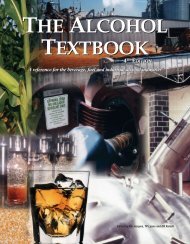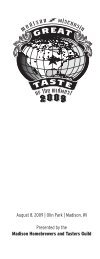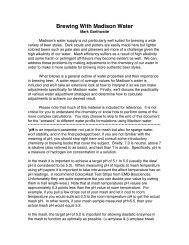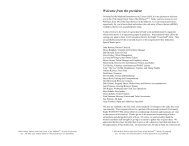The Compleat Distiller
The Compleat Distiller
The Compleat Distiller
You also want an ePaper? Increase the reach of your titles
YUMPU automatically turns print PDFs into web optimized ePapers that Google loves.
THE COMPLEAT DISTILLER 16<br />
• We have 10 kg of sugar, and a 35-liter fermenter. What % alcohol will we get?<br />
(This time we know weight of sugar and volume. Re-arrange the equation again to get<br />
g/l sugar = weight sugar ÷ volume x factor<br />
= 10 kg ÷ 35 liters x 1000 = 28.6 % sugar<br />
(now, calculate % alcohol from g/l sugar, by dividing by 17)<br />
% ethanol = g/l sugar ÷ 1.7<br />
286 g/l sugar ÷ 17 = 16.8 % ethanol<br />
Dr. Cone's methods for high alcohol fermentation<br />
Method #1<br />
This method uses a lot of yeast, because about 80 % of it will die during the first day or so of<br />
fermentation due to the high sugar content.<br />
• Start with sugar concentration of 400 grams per liter of solution.<br />
• Add 1/2 gram Fermaid K® (or equivalent) per liter (2 grams per US gallon).<br />
• Add at least 2 grams properly re-hydrated yeast per liter (8 grams per US gallon).<br />
• Add 1/8 gram potassium or calcium carbonate per liter ( 1/2 gram per US gallon) initially.<br />
• Add 1 gram DAP per liter (4 grams per US gallon) divided into at least three doses, spread out<br />
over the first half of the fermentation.<br />
• Ferment between 21º and 26.5º C (70 – 80º F).<br />
• Aerate, stir or pump around for the first 48 hours.<br />
• Monitor the pH carefully, keeping it between 3.4 and 4.0. Add potassium or calcium carbonate as<br />
needed to keep in this range.<br />
• Stir occasionally after fermentation slows down to keep the yeast suspended.









